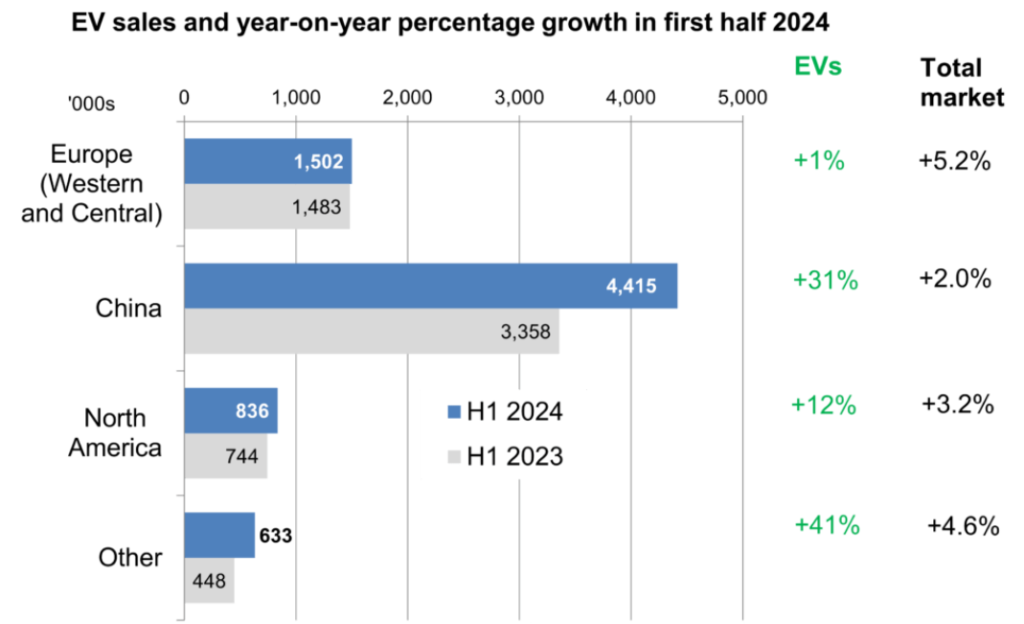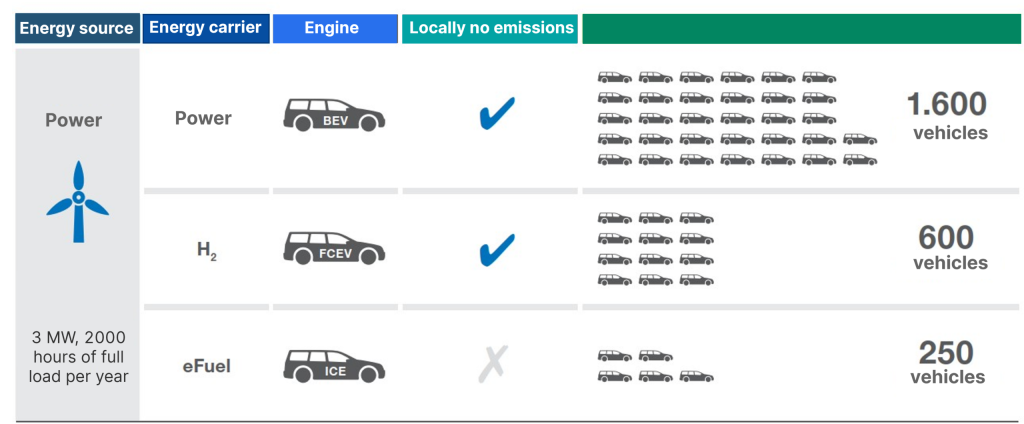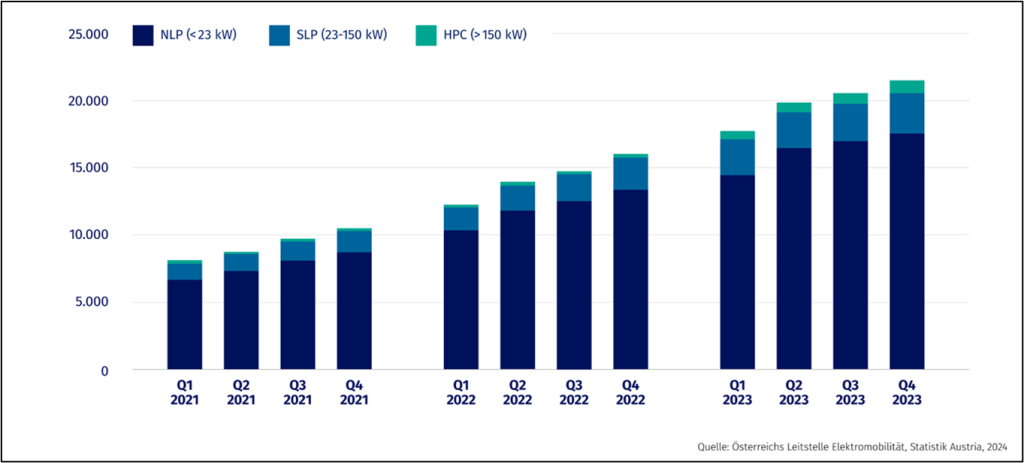The future of mobility seems to have entered an impasse. On the one hand, there are uncertain consumers who are hesitant to buy electric cars, and on the other hand, there are nervous carmakers who are finding it increasingly difficult to strike a balance between e-cars and combustion engines in the midst of the mobility transition. All of this is reason enough to take a fact-based look behind the scenes and see in what direction the (automotive) journey into the future could actually go.
European carmakers in conflict
Anyone who has followed the media in recent weeks has been made aware that the European automotive industry is not exactly going through easy times. The bleak economic outlook is particularly weighing on this traditionally cyclical sector. For example, the German car giant VW announced that it would be ending the job security scheme that had been in place since 1994 and that redundancies from July 2025 were on the cards. Several carmakers (including VW) have already revised their profit forecasts for the current year downwards.
Logically, reports like these did not fail to leave their mark on investors on the stock market either: the major German carmakers VW, Mercedes and BMW, as well as other important European players such as Renault and Stellantis, have incurred shared price losses of 20% or more in the past six months.
A glance beyond Europe’s borders illustrates the dilemma in which European manufacturers currently appear to find themselves. While demand for electric cars is rising sharply in key global markets such as China, electric vehicles are becoming less and less popular in their domestic markets. What’s more, Chinese manufacturers, who started focusing on e-mobility much earlier, are increasingly entering the European market with cheaper models, to the extent that the EU has been forced to announce punitive tariffs on e-cars from China.
Uncertainty leads consumers to hesitate
All of this has hardly helped to give the insecure consumer a clear perspective. Their purchasing decision would actually give them the lever for mobility change. But so far, they have been very hesitant when it comes to deciding on an electric vehicle. The current registration figures reinforce this impression: in July, almost 12% fewer pure electric cars were newly registered in Austria than in the previous year.
Austria is not alone in experiencing this trend. Almost all of Europe is confronted with stagnating or declining registration figures for electrically powered vehicles – in Germany, there has even been a decline of almost 31%. Only in China, where more than 50% of all electric cars registered worldwide are on the road, are registration figures skyrocketing unabated.

Dearth of registrations: the mobility transition from combustion engines to e-cars has so far only picked up speed in China. Source: EV Volumes
Norway has gone electric
A glance at Norway illustrates that things can be done differently in Europe and that it is entirely possible to persuade people to switch to electric cars. An incredible 94% of newly registered vehicles there now run on electricity. This development has been made possible by a decisive change of course by the Norwegian government and a targeted tax policy: while electric cars are promoted by significant tax breaks, combustion engine cars are subject to high taxes. Also, electric car owners enjoy lower fees for parking spaces and toll roads and can also use bus lanes. As early as next year, Norway will no longer register any new petrol or diesel cars (source: newmobility.news).
A megatrend with teething troubles
The example of Norway in particular highlights that the switch to electric mobility is very much a megatrend that only needs the right conditions to flourish. Above all, the increasingly noticeable effects of climate change are causing the population to rethink. The switch to electric mobility not only benefits the environment by reducing the exchange of pollutants, but also those companies that develop innovative storage technologies.
Despite the continuing objections and doubts, there are some facts that suggest that the mobility turnaround is clearly moving in the direction of electric energy. Here is a brief fact check:
Electric, hydrogen, or e-fuel?
In the discussion about the mobility transition, hydrogen and e-fuels are repeatedly brought up as alternatives to electric propulsion. Do the proponents have a point?
When it comes to energy efficiency, electrically powered vehicles are clearly ahead. Through the interaction of the electric motor and battery, as well as the recovery of braking energy through recuperation, they achieve an extremely high overall efficiency of 81%.
By comparison, only 26% of the energy is used for the actual movement in a hydrogen car. Combustion-engine vehicles with e-fuel only achieve an overall efficiency of 14%. Electrically powered vehicles therefore clearly come out on top in this comparison.
Energy efficiency by direct comparison

Comparison of efficiency: the energy produced by a wind turbine is enough to power 1,600 electric cars – for hydrogen or e-fuel cars, the energy is enough for significantly fewer vehicles. Source: VDE
New solutions for old weaknesses
From the lack of charging infrastructure to insufficient range – the list of reservations about electric cars, some of which are certainly justified, is long. However, due to massive investments and technological developments, the points of criticism are diminishing on a monthly and yearly basis.
Better charging infrastructure
There is no doubt that an adequate level of charging infrastructure is needed to promote e-mobility. Just as petrol stations sprang up across the country during the transition from the horse-drawn carriage to the car, more and more charging points for e-cars are now popping up at home. In recent years, the number of charging points has more than doubled. With over 26,000 public charging points, Austria is currently one of the European leaders.
Meanwhile, more and more petrol stations are also recognising the need to “go with the flow”: the number of petrol stations with an electric charging function rose from 107 to 168 in 2023, an increase of 57%. In total, there are now 482 fast-charging stations at petrol stations in Austria, which are mainly located along the motorways. And the number is growing all the time: Shell, for example, has announced that it will equip all petrol stations with fast chargers over the coming two years.
Number of charging points by power output
Over the year from 2021 to 2023

Full charge: In recent years, the number of charging points in Austria has more than doubled. Source: Österreichs Leitstelle für Elektromobilität (OLÉ; Austria Competence Centre for Electromobility), Statistics Austria
Higher range
The issue of range plays a central role for potential buyers of electric cars. According to a study by the European Energy Transition Magazine, most respondents believe that the range should be at least 400 to 500 kilometres or more. Many new electric cars now meet this crucial threshold.
In the past few years, we have seen huge advances in this area too: while e-cars could just about manage a little over 150 kilometres ten years ago, these figures have roughly tripled since then. Improvements in battery technology and efficiency gains have contributed to this. And it looks like this upward trend will continue.
Research is currently being conducted worldwide to develop even more effective and powerful batteries that will enable both greater ranges and shorter charging times. For example, the European consortium SOLiDIFY recently presented a new battery that has over 20 per cent more energy density than conventional lithium-ion batteries.
Promising innovations are also coming out of China, where, among other things, the largest battery cell producer for passenger vehicles, CATL, is based. The “Shenxing” battery, made of lithium iron phosphate, is not only supposed to achieve ranges of up to 1,000 kilometres, but it can also be charged within ten minutes with enough electricity for a 600-kilometre drive.
A research team at Chalmers University of Technology in Sweden is taking a completely different approach with its “massless energy storage” technology: the aim is to replace the heavy aluminium body of an electric car with a lightweight carbon fibre body that also serves as a battery. If this approach were to turn out successful, it could herald a completely new era of e-mobility with significantly higher ranges. But that is still a long way off.
The use of solid-state cells as a replacement for lithium-ion batteries is a much more near-term goal. Due to their extremely high energy density, they are considered the next big step in battery development and should be ready for market by 2027 or 2028. It will then be possible to drive 1,000 kilometres on a single battery charge, and the charging time will be less than ten minutes.
Shorter charging times
Hand in hand with the further development of battery and charging technology, charging times have also been significantly reduced in recent years. Depending on the power supply, charging times of less than ten minutes are already possible today with high-power charging stations at motorway service stations. If this development continues, charging at a charging station will one day be as fast as refuelling at a petrol pump.
The thing about electricity consumption
One argument that is often put forward against electric mobility is the additional demand for electricity, the supply of which is not guaranteed. Is that really a showstopper?
The switch to electric mobility will undoubtedly be accompanied by an overall increase in electricity demand. However, according to the Austrian Mobility Master Plan, the increase will be significantly lower than expected and should only be 6.5% by 2030. The reason for this is the high efficiency of electrically powered vehicles, which, among other things, convert kinetic energy back into electricity for the battery during braking. Even if the entire Austrian fleet of passenger cars were fully electrified by 2040, today’s electricity demand would only increase by 21 %.
According to information from the Climate and Energy Fund, total energy demand in the transport sector can be reduced by almost 60% by 2040 if electrification is intensified. A condition for climate-friendly electric mobility is that the electricity required for it comes from renewable energy sources – and here, Austria is on the right track with a current share of 85%. In addition to the traditionally strong hydropower, there has also been a significant increase in photovoltaics and wind power recently, which is expected to continue.
The commodity question
Regardless of the technology used, finite raw materials are required for the production and operation of a vehicle. In the case of conventionally powered vehicles, these primarily come by way of the extraction and refining of crude oil, whereas in the case of electric mobility, the focus is on metallic and semi-metallic raw materials such as lithium or cobalt – which, incidentally, are also needed for smartphones or laptops.
Initiatives are currently being launched worldwide to sustainably improve the environmental and social conditions under which these raw materials are extracted – including the Responsible Cobalt Initiative (RCI), the Initiative for Responsible Mining Assurance (IRMA), and the Drive Sustainability initiative. Initiatives such as these, along with global industry alliances, aim to reduce the negative environmental impacts of raw material extraction and to positively influence working conditions in mining and living conditions in the affected regions.
In addition, politics is also introducing accompanying measures. Among them are, for example, the OECD Due Diligence Guidance for Responsible Supply Chains of Minerals from Conflict-Affected and High-Risk Areas and the EU Battery Regulation.
Aside from all these efforts, the development of innovative battery technologies should also help to ease the resource issue. One example of this is sodium-ion batteries, which are produced without the scarce lithium.
Conclusion
There is no disputing that the mobility transition is a decisive lever in the fight against climate change. Only with a low-CO2 form of mobility will it be possible to achieve such important milestones as meeting the 1.5-degree target. So, the future of mobility must be low in pollutants, but is it also electric? The figures clearly support this.
Range, charging infrastructure, electricity demand: the question marks that have existed so far with regard to e-mobility are increasingly dissipating. Also, e-cars are far more efficient than other alternative mobility types that have been discussed.
But what does this mean for investors? Should they focus on shares of e-car pioneers? In our equity fund ERSTE GREEN INVEST, the fund management team takes a different approach. No matter what manufacturer offers the greatest range or the best technology, the corresponding charging infrastructure and battery solutions will be needed regardless. The fund therefore focuses primarily on companies that are driving the expansion of the e-car infrastructure.
Fund manager Clemens Klein highlights this point: “We are not trying to find the next Tesla or predict who will be most likely to succeed with their technology and approach, even though we can certainly see many exciting players in this field. However, the charging infrastructure will be needed regardless of who comes out on top. All these electric cars have to be charged somewhere, so we are convinced that this topic will continue to deliver strong growth.” Please note: forecasts are no reliable indicator of future performance.
Investing in environmental technologies
The ERSTE GREEN INVEST environmental equity fund offers you the opportunity to invest in a broadly diversified portfolio of pioneers in the field of environmental technology, with a focus on energy, water, waste and recycling, transformation, and adaptation. As an impact fund, it aims to achieve a measurable, positive impact on the environment and society.
👉 Mehr erfahren
Notices ERSTE GREEN INVEST
Please note that investing in securities involves risks as well as the opportunities described.
The fund pursues an active investment policy and does not follow a benchmark. The assets are selected at our discretion, without any constraints to the latitude of judgement on the investment company’s part.
For further details on the sustainable strategy of ERSTE GREEN INVEST and on the Regulation (EU) 2019/2088 of the European Parliament and of the Council of 27 November 2019 on sustainability‐related disclosures in the financial services sector and the Taxonomy Regulation (Regulation (EU) 2020/852) please refer to the current prospectus, point 12 and the appendix, “Sustainability principles”. When deciding to invest in ERSTE GREEN INVEST, please take into account all features and goals of ERSTE GREEN INVEST as described in the fund documents.
Benefits for the investor
- Broadly diversified investment in equities from global equity markets
- Participation in ecologically, ethically, and socially acting companies
- Active selection of companies where we identified a particular degree of environmental utility on the basis of a pre-defined selection process
- Chances of attractive gains
Risks to bear in mind
- The price of the fund may be subject to significant fluctuations
- Due to investment in foreign currency, the value of the fund may be affected by foreign exchange fluctuations
- Capital loss is possible
- The following risks may be of particular relevance to the fund: credit risk, counterparty risk, liquidity risk, deposit risk, derivative risk, and operational risks. For comprehensive information on the risks of the fund, please refer to the prospectus and to the information for investors according to sec. 21, part II, chapter “Risk notices” of the Austrian Alternative Investment Fund Managers Act
Legal disclaimer
This document is an advertisement. Unless indicated otherwise, source: Erste Asset Management GmbH. The language of communication of the sales offices is German and the languages of communication of the Management Company also include English.
The prospectus for UCITS funds (including any amendments) is prepared and published in accordance with the provisions of the InvFG 2011 as amended. Information for Investors pursuant to § 21 AIFMG is prepared for the alternative investment funds (AIF) administered by Erste Asset Management GmbH pursuant to the provisions of the AIFMG in conjunction with the InvFG 2011.
The currently valid versions of the prospectus, the Information for Investors pursuant to § 21 AIFMG, and the key information document can be found on the website www.erste-am.com under “Mandatory publications” and can be obtained free of charge by interested investors at the offices of the Management Company and at the offices of the depositary bank. The exact date of the most recent publication of the prospectus, the languages in which the fund prospectus or the Information for Investors pursuant to Art 21 AIFMG and the key information document are available, and any other locations where the documents can be obtained are indicated on the website www.erste-am.com. A summary of the investor rights is available in German and English on the website www.erste-am.com/investor-rights and can also be obtained from the Management Company.
The Management Company can decide to suspend the provisions it has taken for the sale of unit certificates in other countries in accordance with the regulatory requirements.
Note: You are about to purchase a product that may be difficult to understand. We recommend that you read the indicated fund documents before making an investment decision. In addition to the locations listed above, you can obtain these documents free of charge at the offices of the referring Sparkassen bank and the offices of Erste Bank der oesterreichischen Sparkassen AG. You can also access these documents electronically at www.erste-am.com.
Our analyses and conclusions are general in nature and do not take into account the individual characteristics of our investors in terms of earnings, taxation, experience and knowledge, investment objective, financial position, capacity for loss, and risk tolerance. Past performance is not a reliable indicator of the future performance of a fund.
Please note: Investments in securities entail risks in addition to the opportunities presented here. The value of units and their earnings can rise and fall. Changes in exchange rates can also have a positive or negative effect on the value of an investment. For this reason, you may receive less than your originally invested amount when you redeem your units. Persons who are interested in purchasing units in investment funds are advised to read the current fund prospectus(es) and the Information for Investors pursuant to § 21 AIFMG, especially the risk notices they contain, before making an investment decision. If the fund currency is different than the investor’s home currency, changes in the relevant exchange rate can positively or negatively influence the value of the investment and the amount of the costs associated with the fund in the home currency.
We are not permitted to directly or indirectly offer, sell, transfer, or deliver this financial product to natural or legal persons whose place of residence or domicile is located in a country where this is legally prohibited. In this case, we may not provide any product information, either.
Please consult the corresponding information in the fund prospectus and the Information for Investors pursuant to § 21 AIFMG for restrictions on the sale of the fund to American or Russian citizens.
It is expressly noted that this communication does not provide any investment recommendations, but only expresses our current market assessment. Thus, this communication is not a substitute for investment advice.
This document does not represent a sales activity of the Management Company and therefore may not be construed as an offer for the purchase or sale of financial or investment instruments.
Erste Asset Management GmbH is affiliated with the Erste Bank and austrian Sparkassen banks.
Please also read the “Information about us and our securities services” published by your bank.


